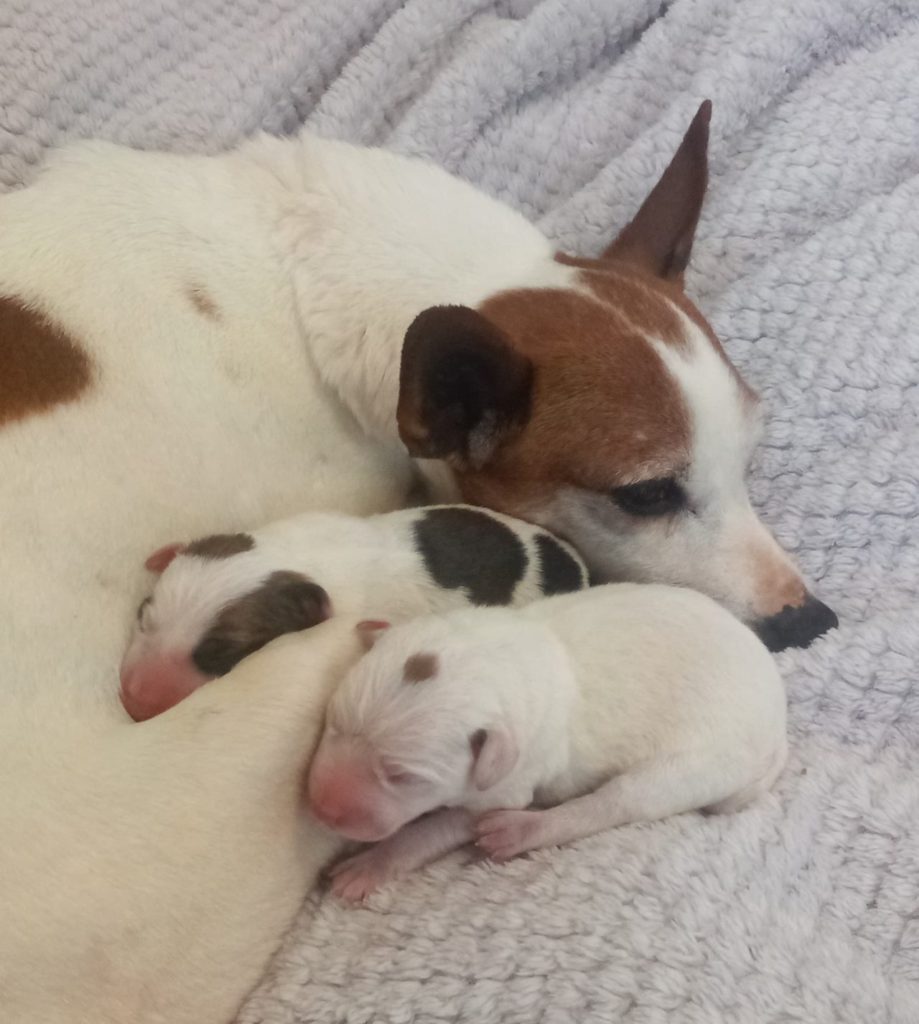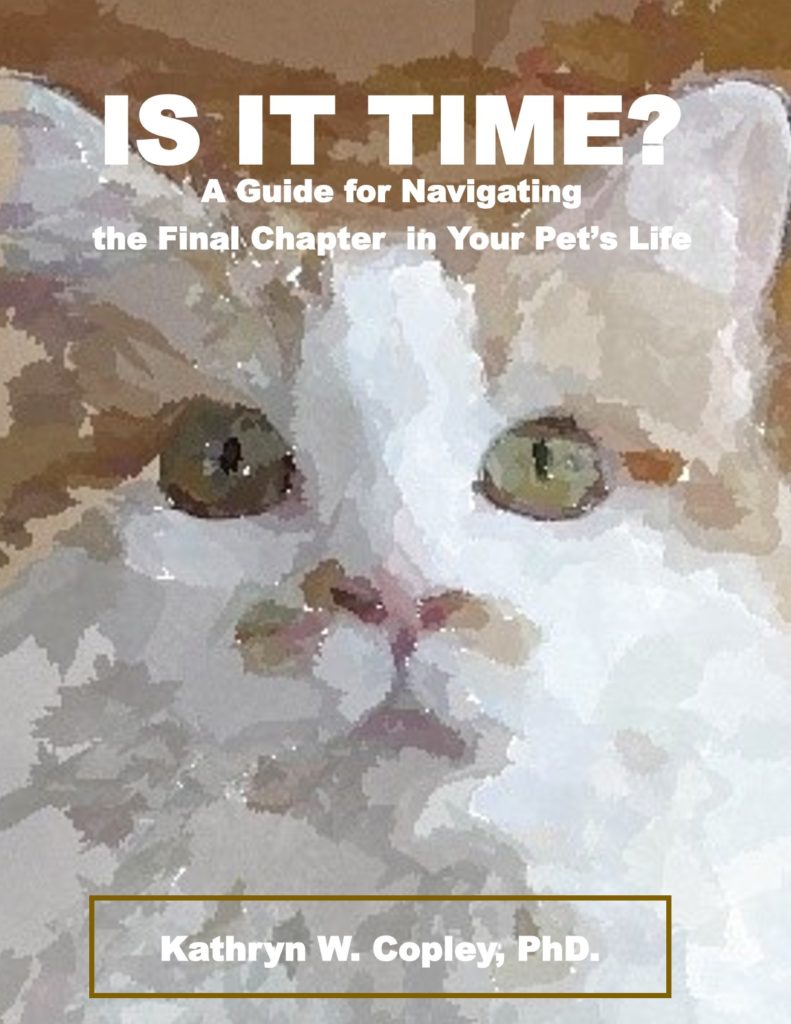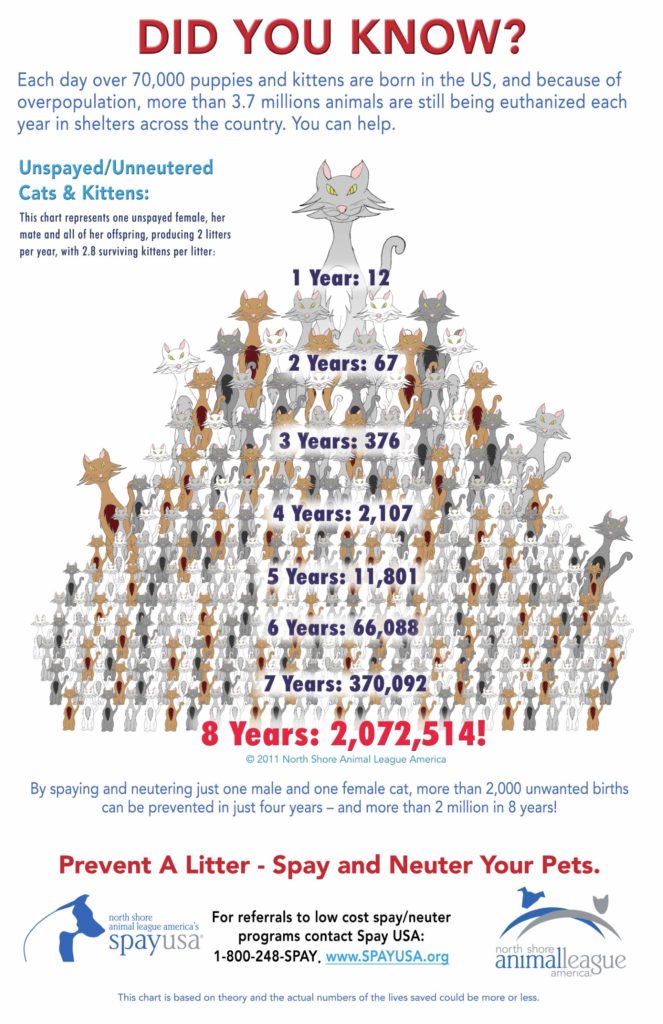Female dogs and cats are spayed. Male dogs and cats are neutered. People also use the terms fix, sterilize, and alter.
Courtesy of SpayUSA
Courtesy of SpayUSA
In 8 years, one unspayed female cat and one un-neutered male cat can produce a theoretical 2,072,514 offspring.


Too often, pregnant dogs and cats — owned or stray — are turned in to shelters to have their kittens or puppies there. If they had been spayed, they would not have these unwanted litters.

SPAY / NEUTER IMPROVES HEALTH, LONGEVITY AND BEHAVIOR
Current thinking is that it is safe to spay (female) and neuter (male) puppies and kittens at 2 pounds and 2 months of age (the animal must be both), and this is what many if not most shelters and animal rescue agencies do to ensure that the dogs and cats adopted from them don’t have litters of their own. There are exceptions, of course, with some problems resulting from spay/neuter at this age. Rely on your veterinarian for the last word.
What does spay/neuter have to do with pet health and longevity?
In addition to eliminating the potential problems that may occur during pregnancy, delivery, and the follow-up mothering for a female dog or cat,….
- Studies have shown a 91% reduction in mammary cancer in cats spayed before the first heat. There are no prevention benefits if spayed after age 2½. Every heat cycle increases your pet’s chance of breast cancer, which can be fatal in about 50 percent of female dogs and 90 percent of female cats (ASPCA).
- Neutering eliminates testicular cancer and decreases the incidence of prostate disease.
- Sterilizing reduces your pet’s urge to roam, which decreases the risk of it getting injured in fights, contracting diseases from bite wounds, running away, or getting hit by a car. A male dog can detect a female dog in heat from 2+ miles away and may roam to find her, with roadways to cross in the process. Surveys indicate that as many as 80% of dogs hit by cars are unaltered.
- The ASPCA says that a sterilized dog or cat lives an average of 2 – 3 years longer than an unsterilized one.
What do spay/neuter have to do with behavior?
- Altered pets tend to be more gentle and affectionate, less interested in other animals, and more focused on their family.
- If you have more than one pet in your household, all the pets are likely to get along better if they are altered.
- Altered pets are less likely to bite, fight, and roam. (Dogs that have not been spayed or neutered are three times more likely to bite [Humane Society of the United States].)
- They are also less likely to spray urine to mark territory inside the house and in the yard (yours and your neighbor’s).
- Female cats in heat can cry incessantly and attract unwanted males. If you spay cats, Romeos will be less likely to hang around your yard.
How does spay/neuter help the neighborhood and community at large?
Because sterilized animals are less likely to roam, they are less likely to engage in behaviors that are dangerous or irritations to neighbors and the general public, like:
- Chasing and killing livestock.
- Marking neighbors’ property with urine.
- Knocking over trash cans or ripping trash bags open.
- Attracting noisy Romeos during heat cycles.
- Roaming in packs and barking.
- Forming feral cat colonies.
- Fighting with and injuring other people’s domestic pets.
Too many unwanted kittens and puppies
Having a pet that has a litter of puppies or kittens is exciting, and they are too adorable and cuddly for words. But what then? Will you find homes for all of them – homes that will spay or neuter them so they don’t continue to contribute to the population increase of unwanted puppies and kittens? Turn them in to an overcrowded humane society shelter – or to an overcrowded county shelter that may euthanize all animals they don’t have room for?
75% of all cat litters are accidental. 50% of dog litters are accidental. Spay/neuter.
About 24 million kittens and puppies are born annually, and 80 – 90% are born to “late spay/neuter” moms (moms that have had at least one litter). Currently, 6 dogs and cats are euthanized every minute in overcrowded facilities. Every dog and cat that is fixed contributes to lowering that number.

All the named animals pictured in this blog were someone’s treasured pet. They may have crossed the Rainbow Bridge, but their absence makes them no less beloved.


I may not know what tomorrow will bring, but remember…today I have you.
